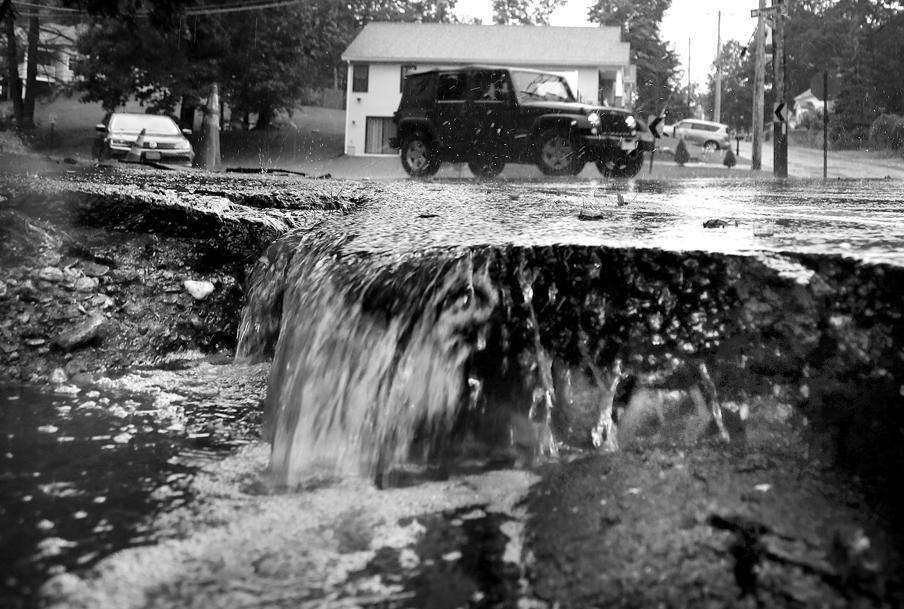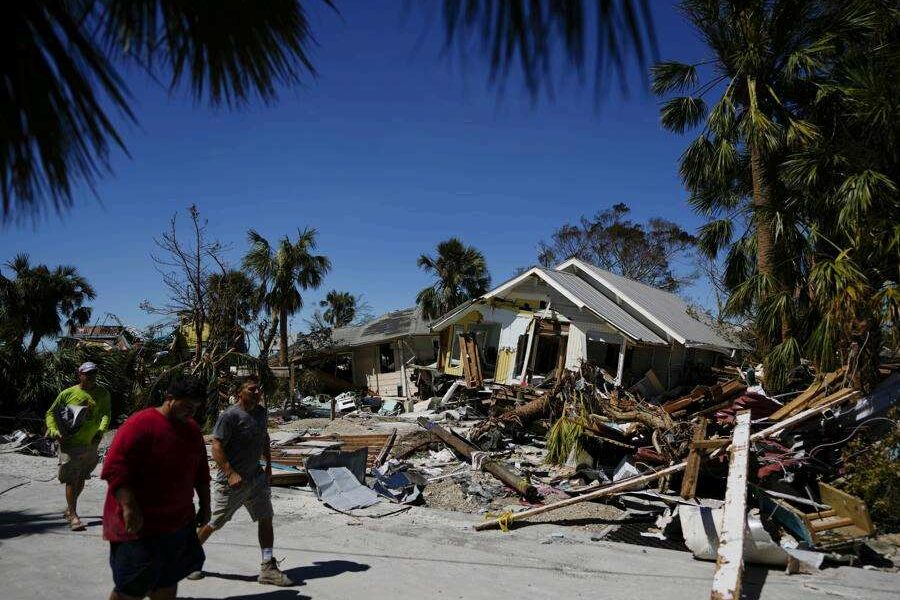
What you need to know about flood insurance as catastrophes like Leominster become more common
By Sean P. Murphy, Globe Staff
Hundreds – maybe thousands – of homes were recently damaged by catastrophic flash flooding in Leominster and elsewhere in New England. Water flooding into basements ruins furnaces, water heaters, and HV AC systems, and can crack foundations. Water destroys electrical systems, plumbing, appliances, and furniture, not to mention family heirlooms. And moisture invites mold. That means drywall, flooring, and insulation may have to be replaced, and clothing and other items thrown out.
The cost of restoring your life can easily run into tens of thousands of dollars.
And climate change is accelerating both the intensity and the frequency of the kinds of storms that hit Leominster, where about a foot of rain fell in a few hours.
At the same time, New England remains susceptible to hurricanes and winter storms that can cause “storm surge” flooding and produce damaging high winds.
It makes you wonder: Is my home adequately insured for this kind of severe weather?
Are the homeowners in Leominster and other hard-hit areas covered?
It depends on what caused the damage to their homes and what kind of insurance they have. Wind damage is covered by a standard homeowners policy. And more than 90 percent of homeowners have a standard policy. But wind was not the main culprit in the most recent storms. It was water.
Do insurers treat water damage differently than wind damage?
Yes. You need a separate “flood” insurance policy for coverage of the kind of damage torrential rains and flash flooding caused throughout New England this summer. Trouble is, many homeowners think their standard insurance policy covers water damage. A little more than onethird of homeowners assumed their standard homeowners policy covers water damage, according to a recent survey.
What does a standard homeowners insurance policy cover?
Losses due to fire and smoke, lightning strikes, windstorms and hail, explosions, vandalism and malicious mischief, damage from an aircraft, car, or vehicle, theft, and falling objects. (Earthquake damage is typically not covered, although you can add it to your homeowners policy at an extra cost, and some people in New England do.)
There’s no coverage for water damage in a standard policy?
Standard homeowners policies generally do cover water damage if, for example, the hose to your washing machine lets go and damages the floor. It usually covers sudden water heater failures and pipe breaks. Basically, you’re covered when damaging water comes from inside your house or through the roof. But you’re not covered for damage caused by rain that hits the ground and then gets into your house.
Can I add flood insurance to my existing standard homeowners policy as an add-on (like earthquake coverage)?
No. You need a separate policy for flood coverage.
Should all homeowners buy flood insurance?
Perhaps not. Some homes are on such high ground or so far from bodies of water as to be relatively safe. But nobody can predict the future – ask homeowners in Leominster – and some insurers argue virtually everyone should have it. This is the way the state Division of Insurance puts it: “Just because your home is not in a designated floodplain, don’t assume you will never have flood damage.” Flooding, it says, is the “most common, costly and deadly” kind of severe weather in the country.
What’s a ‘designated floodplain’?
The federal government has meticulously drawn lines over a map of the whole country showing areas of highest flood risk, based on historical records. The map also shows areas of moderate and low risk. The high and moderate-risk areas are known as floodplains or flood zones. The map’s official name is “flood insurance rate map.” It’s a good place to start when thinking about whether to purchase flood insurance. Even if you discover your house is not in the flood zone, knowing how close you are to it may help you decide whether to purchase flood insurance.
How can I access the map?
You can plug your address into a map maintained by the Federal Emergency Management Agency. The FEMA map requires you to learn a bit of technical terminology before you can fully appreciate it. An easier map to quickly understand is posted by the state.
Is flood insurance required for homes in floodplains?
If your home is in a high-risk flood area and you have a government-backed mortgage you are required to have flood insurance. About 30 percent of mortgages are backed by Fannie Mae, Freddie Mac, or other government entities. Private lenders require flood insurance to protect their collateral. But there is no law requiring flood insurance. (Nor is standard homeowners insurance legally mandated; by contrast, auto insurance in Massachusetts is mandatory.)
How likely are floods in the flood zone?
Houses in the high-risk zones have a 25 percent chance of flooding during the course of a standard 30-year mortgage – far greater than the 10 percent risk of a fire in that same timeframe, according to the DOI.
How can I get flood insurance?
Your homeowners insurance agent or broker may offer it (in a separate policy). If not, you may be able to buy it from another agent or broker. If you can’t get it from a private insurance carrier, because the risk is deemed too high, there’s the National Flood Insurance Program, which is run by the federal government.
How much does flood insurance cost?
The average flood insurance cost in Massachusetts is $1,305 per year, according to the website MoneyGeek. The average cost for a policy from the federal government is $1,026, according to the website ValuePenguin. For those in the moderate and low-risk flood areas, flood insurance costs about $500; for those in the highest-risk area, it can go well into the thousands, according to agents I spoke with.
The average cost of standard homeowners insurance in Massachusetts is about $1,320 a year, according to the website NerdWallet.
What about deductibles?
Under the National Flood Insurance Program, you can increase the deductible on your flood insurance policy to a maximum $10,000, which could reduce your annual premium by up to 40 percent. (Many standard policies have two kinds of deductibles for coastal homes, one for wind damage, and one for damage due to “other perils.” The deductible for wind is usually the higher one, because of its destructive potential.)
Are flood-damaged motor vehicles covered?
Not by your standard homeowners or flood insurance policies, but your auto insurer will cover your vehicle if you have opted for comprehensive insurance, which covers damage caused by something other than an accident, such as a tree falling on your vehicle, vandalism – or flooding.
How do I know if my standard homeowners policy offers adequate coverage?
Carriers insist you have 100 percent replacement coverage (the cost of replacing your house with materials of “like kind and quality”). If your coverage dips below 85 percent, carriers will impose a penalty on you, significantly lowering the amount they will pay for a claim.
Can insurance companies refuse standard coverage?
If an insurer thinks your house is too risky, it can say no to either a new policy or a renewal of an existing one. One reader who owns a house on Martha’s Vineyard contacted me to say her homeowners insurer quoted her a renewal cost of more than $25,000 on a policy then costing $3,500. That’s one way for an insurer to indirectly but emphatically say no to a renewal. The reader shopped around and got a policy for $6,500. (The best advice to consumers wanting to lower their insurance cost is to shop around.)
Do insurers consider claims history when quoting a price?
Yes, but also location, kind, and size of house, and the homeowner’s credit score.
What if I can’t find a willing insurer for a standard policy?
There’s a state-created “insurers oflast resort,” known in Massachusetts as the FAIR plan. It insures up to a maximum of $1 million in replacement costs. About 10 percent of homeowner premiums in the state are paid under the FAIR Plan. Of course, the premiums are high due to the risk. Details about the Massachusetts FAIR Plan can be found online.
How does climate change affect homeowners insurance?
The more damage caused by storms and wildfires, the more the insurance industry must pay in claims. And, of course, higher claims mean higher premiums. A report from First Street Foundation released last week says roughly one-quarter of all homes nationally are”underpriced for climate risk,” meaning those homeowners are likely to be hit with significantly higher premiums.
Got a problem? Send your consumer issue to sean.murphy@globe.com. Follow him @spmurphyboston.


